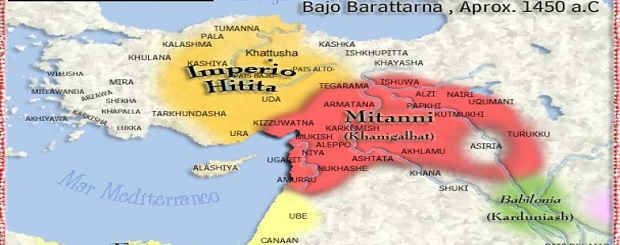
Armenian kingdom of Mitanni (One House in Armenian)
Egyptian sources call Mitanni “nhrn”, which is usually pronounced asNaharin/Naharina from theAssyro-Akkadian word for “river”, cf. Aram-Naharaim. The name Mitanni is first found in the “memoirs” of the Syrian wars (ca. 1480 BC) of the official astronomer and clockmaker Amememhet, who returned from the “foreign country called Me-ta-ni” at the time ofThutmose I. The expedition to the Naharina announced by Thutmosis I at the beginning of his reign may have actually taken place during the long previous reign of Amenhotep I Helck believes that this was the expedition mentioned byAmenhotep II.

The kingdom of Mitanni was a feudal state led by a warrior nobility of “Armeno-Aryan” origin, who entered the region of Aram Nahrain/Nairi (Aram Nahabed’s time) on the Orontes south of Mukis and Niya and North of Aram during 1700 BC as vassals of the Hittites. The Armenian patriarch Aram, corresponds to Aram-Naharin, Aram of 2 Rivers, the Tigris and Euphrates, the location and alternative name of Mitanni.
Eusebius, writing in the early 4th century, quoted fragments of Eupolemus, a now-lost Jewish historian of the 2nd century BC, as saying that “around the time of Abraham, the Armenians invaded the Syrians”. This corresponds to the arrival of the Mitanni, since Abraham is traditionally assumed at around the 17th century BC.
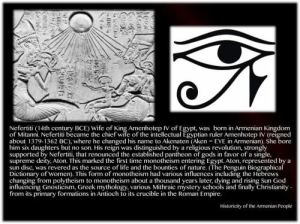
In the 33rd year of his reign, while he was in the Armenian Highlands in 1446 BC, Thutmose III of Egypt, referred to the people of Ermenen (Armenians), and says in their land “heaven rests upon its four pillars”. Under the reign of Tuthmosis IV, friendly relations were established between the Egyptians and the Mitanni. The daughter of King Artatama was married to Tuthmosis IV. The constellation of Hayk (Orion) in the Egyptian pantheon represented Osiris, and he was the Destiny of Pharaonic Ka after [Ba or Mer — Ban in Armenian is anonymous with divine Ēut’iwn — the royal insignia of Mitanni represented the official religion of the state — the Orion-Aryan sun cult — as a winged sun disk — surrounded on both the Right and Left by a pair of eagles and lions — symbolic of the solar power/energy.
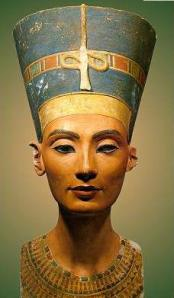
The Sun/Son Orion (Christ-Krist Karast from Egyptian) rising from the East (Orient)… Akhenaten instated the Mitanni Aryan [Orion] solar cult as the official monotheistic [ONE God] religion of Egypt. The Armenian Orion Cult based in and around the sacred Mitanni city of Urhai [Ourhai or Ori-On] was the sacred religion guarded by the high priest Egyptian kings [going back to ages of recorded history]. This symbolism was also adopted by the Egyptian pharaohs [hence the winged sun disk and the Ba bird [connected with Ban] as the symbol of the immortal Soul that flew to the astral heaven — represented by the hawk/eagle headed Hor[us] Arev the eventful journey to the Invisible Sun (Ararich/Creator/Source of Life).
At the height of its power, during 1400 BC, it had outposts centered around its capital, Vachukanni, whose location has been determined by archaeologists to be on the headwaters of the Khabur. Their sphere of influence is shown in Mitanni place names, personal names and the spread through Syria of a distinct pottery type. The association of this pottery with the Kura-Araxes culture has been found. The Mitanni are regarded by many historians as the ancestors of the modern day Armenians.
Hurri n.
( pl. same or Hurris) a member of a people, originally from Armenia, who settled in northern Mesopotamia and Syria during the 3rd-2nd millennium bc and were later aborbed by the Hittites and Assyrians. (See also Mitanni.) Hittite & Assyrian Harri, Hurri.
The Oxford English Reference Dictionary, © Oxford University Press 1996
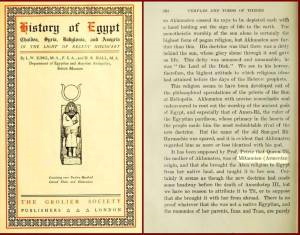
There is no question that the Hurrian and Araratyan (Urartian) languages were very similar, and some have used this evidence that the Hurrian-Armenian tribes had origins in the Urartu (Ararat) area in and around Lake Van before migrating to South-Western Armenia. The Hurrian timeframe in Syria (South-Western historic Armenia), the area that the Hurri-Mitanni kingdom of Armenia was present (c. 2300 BC -1200 BC) predates the timeframe of Urartu in Eastern Armenia (c. 1000-585), it is more often considered likely that the Armenians of Urartu (Ararat) had origins there, and fled from the South-Western Armenian Highlands into the Eastern part of Armenia after the Hittites and Assyrians conquered the region. Chronologically, the Urartian language seems to be a continuation of Hurrian dialects, and not the other way around.
I got another interesting source about Queen Thiy: in the opinion of the Father of Egyptian Archaeology William Matthew Flinders Petrie, she was of Armenian origin and she brought the Aten religion to Egypt from her native land – Armenian Kingdom of Mitanni – and taught it to her son.
She is the mother of Akhenaten, mother in law to another future Egyptian queen of Armenian Mitannian origin Nefertiti and grandmother of Tutankhamun.
Tiye was married to Amenhotep III by the second year of his reign. He had been born of a secondary wife of his father and needed a stronger tie to the royal lineage. He appears to have been crowned while still a child, perhaps between the ages of six to twelve. They had at least seven, possibly more children.
In the 33rd year of his reign, while he was in the Armenian Highlands in 1446 BC, Thutmose III of Egypt, referred to the people of Ermenen (Armenians), and says in their land “heaven rests upon its four pillars”. Under the reign of Tuthmosis IV, friendly relations were established between the Egyptians and the Mitanni.
Michael Cohen in “Iraq: Small statue of Egyptian pharaoh found” writes:
“The Mitanni Kingdom was a powerful force around 15-1300 BC and are regarded by many historians as the ancestors of the modern day Armenians”.
“The Hurri-Mitanni kingdom of Armenia kept close contact with its western neighbor, Hittite or Hatti land. Masses of population were often transplanted from one country to the other.
Mitanni King Artatama’s (Armenian Arta prefix) title was “King of the Hurrians” (yet again reveals the Hurrian-Aryan links).
As far as it’s mentioned the Mittani princess who married Pharaoh got a name given in Egyptian way as Thiye. There was DNA analysis of Pharaoh’s mummies and it is posted on the Facebook that shows he is R1b which is clearly Indo-European, u can check this web http://voices.yahoo.com/does-pharaoh-tutankhamens-european-genes-confirm-that-12124134.html?cat=37
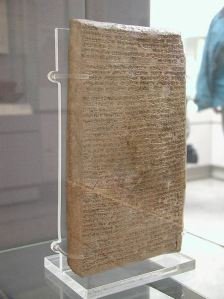
The Mitanni armies were composed of highly skilled professional troops. Their elite warriors were the maryannu, the horsemen and the charioteers of the aristocracy. The Mitanni chariots served as the models for the chariots of the neighboring armies. Mitanni chariots were sleek platforms with two wheels and a team of two horses. The horses and the maryannu warrior were well armored — covered in bronze or iron scale armor. The attendants included archers that would fight with the noble charioteer from the chariot and the servants would attend the horses. The Armenian-Hurrian-Hyksos [Hayksos] extended their domain through Palestine to Egypt.
According to the archeological excavations carried out during the 19th – 20th centuries in western Asia and, particularly, in the Armenian Highland wealthy cultures establish which are known by the names of the Konya lowland, Neolithic, Halaf-Hasun (later Samarian), Shengavitian or Kur-Arax and so on. The homeland of these cultures is northern Mesopotamia, the Armenian Highlands and neighbouring areas. At the sources of these cultures and civilizations were the autochthones of the Armenian Highland – the Hurries (Hay-Armenians).
After Mitanni the states of the Hittits (the beginning of 12-th century B.C.) and Egypt (the end of I century B.C.) also vanished from the historic arena. And while these states vanished leaving only the name and the culture, the state of Mitanni had a new continuation on behalf of a state of Ararat-Urartu formed at the beginning of the 9-th century B.C.
http://westernarmeniatv.com/en/history/english-armenian-kingdom-of-mitanni-one-house-in-armenian/
